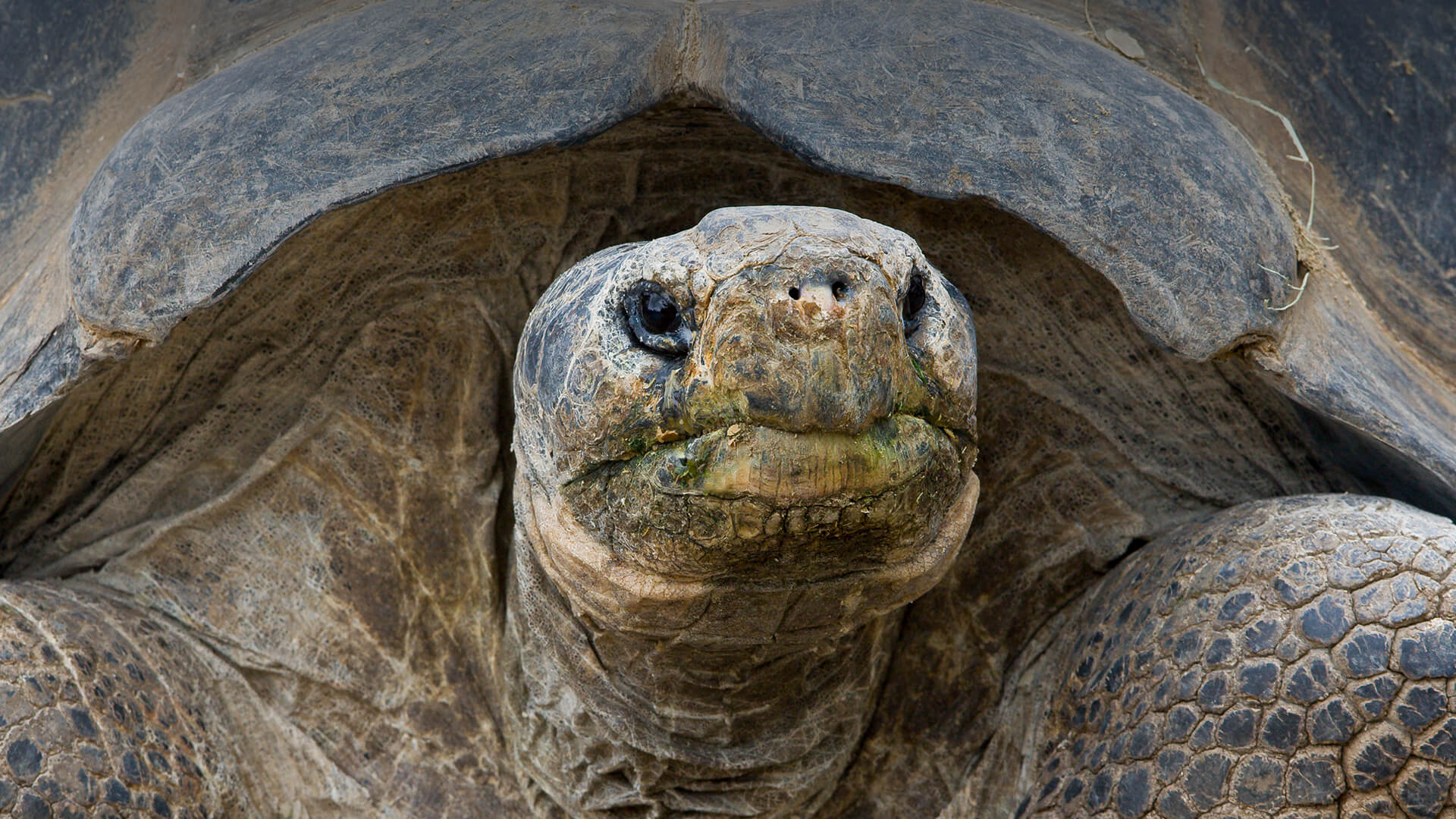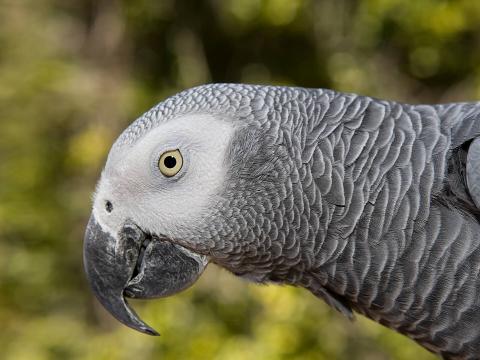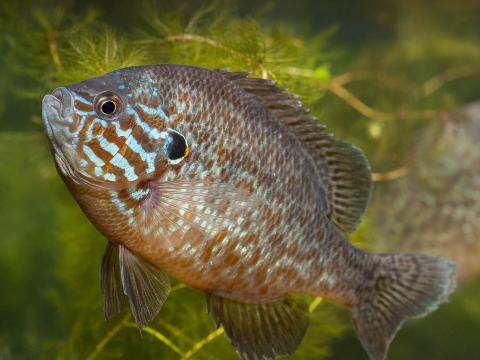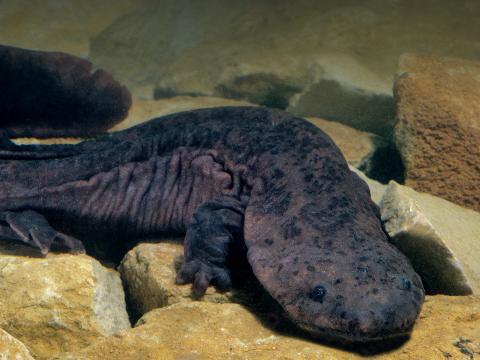Galápagos Tortoise
- CLASS: Reptilia (Reptiles)
- ORDER: Testudines
- FAMILY: Testudinidae
- GENUS: Chelonoidis
- SPECIES: nigra
ABOUT
Adapting and surviving: Galápagos tortoises are the giants of the tortoise world. Males can weigh more than 500 pounds (227 kilograms), and females average about 250 pounds (113 kilograms). They have thick, sturdy legs to hold up all that weight, but they still spend a lot of time lying down to conserve energy. There are two types of Galápagos tortoises. The largest, with big, round shells, are called “domes.” The smaller kinds of tortoises have shells that curl up in front like a saddle and are called “saddlebacks.”
Although they are massive animals, their shells are not solid. Instead, they are made up of honeycomb structures that enclose small air chambers. This makes it possible for the tortoise to carry the weight of the shell without much difficulty. The shell encompasses the animal’s ribs, so a tortoise cannot "walk out" of its shell, like you may see in cartoons. The lungs are located on the top of the tortoise’s body, under the top dome of the shell.
When threatened, the tortoise pulls itself into its shell with a hiss. The hissing sound is just the tortoise letting air out of its lungs. If a fight breaks out among males, the tortoises face each other with ferocious glares, open their mouth, and stretch their head as high as they can. Whoever reaches the highest wins, even if he is much smaller overall than the other male! The loser pulls his head in with a noisy hiss, and the battle is over. To us, this looks like they’re just putting on a show; but it’s a serious matter to the tortoises, especially in the wilderness, where fights occur over mates or a specific food item or clump of food.
HABITAT AND DIET
Island giants: Naturalist Charles Darwin made his historic voyage on the HMS Beagle from 1831 to 1836. When the ship sailed around the Galápagos Islands, he and his shipmates marveled at the animal life they found, from blue-footed boobies and marine iguanas to giant tortoises. One thing that caught his eye was that each of the 13 larger islands in the Galápagos Islands had a slightly different form of giant tortoise.
Each was uniquely suited for survival on that particular island’s environment. For example, domed shells were found on tortoises living in highlands with lush pastures. Saddleback shells gave the tortoises on other islands more flexibility to reach sparse vegetation found higher off the ground, allowing them to stretch their neck to eat from bushes and cactus. On islands with sparse vegetation, the tortoises have longer legs to climb a little and reach food growing up high; these tortoises tend to be smaller, possibly to help them travel through their harsher habitat.
Galápagos tortoises tend to lead a peaceful, quiet life that centers on eating, relaxing in the sun, or wallowing in puddles. Because they are cold-blooded like other reptiles, they like to soak in the sun to warm up. At night, they may rest partially submerged in mud, water, or brush to keep warm during cool evenings. Mud wallows can also keep a tortoise cool during the day.
There’s nothing like a nice, slow, ambling walk if you’re a tortoise. The feet on the powerful front legs are turned inward, so each step moves the tortoise from one side to the other and never in a straight line. Tortoises rarely just stand up and walk, however; they prefer to put some weight on the front legs before pushing with the back feet and sliding forward.
Galápagos tortoises are herbivores that eat prickly pear cactus (a favorite) and fruits, as well as flowers, leaves, and grasses. In fact, these tortoises can go without eating or drinking for up to a year, because they can store food and water so well. Tortoises don’t have teeth, so they use the bony outer edges of the mouth to bite off and mash food. Once in the mouth, food is quickly swallowed. They don’t have a good sense of smell, so they use their eyes to find food. Anything red really gets their attention!
At the San Diego Zoo, the tortoises are offered kale, collard, mustard and dandelion greens, bok choy, and seasonal fruits and vegetables. Galápagos tortoises can retain a great amount of water, which allows them to survive the long dry season on the islands.
FAMILY LIFE
When giant tortoises reach maturity, at about 20 to 25 years of age, they begin to think about reproducing. In the wilderness, their breeding season is generally between January and August. After mating, the females begin a journey of several miles to reach nesting areas. They look for dry, sandy ground and dig a hole about 12 inches (30 centimeters) deep. Here they lay hard-shelled eggs the size of tennis balls and cover them up with sand.
Temperature plays a role in whether a tortoise hatchling is male or female: if the nest temperature is low, more males hatch; if it is high, more females hatch. When the young tortoises emerge from their shells, they must dig their way to the surface, which can take up to one month! It’s then up to them to survive on their own, as the mother does not stay to help them.
AT THE ZOO
The San Diego Zoo has one of the largest colonies of Galápagos tortoises in the world. We have had these giants in our care since 1928, making them the oldest residents in the Zoo. That’s the year when Charles Townsend of the New York Zoological Society began his efforts to save the tortoises from extinction by collecting juvenile tortoises and setting up colonies for them in North American zoos. These tortoises weighed between 11 and 30 pounds (5 to 13 kilograms), and it would be years before they reached breeding size.
Many of the original tortoises are well over 100 years old today. Our first Galápagos tortoise hatching occurred on October 21, 1958. Since then, we’ve had more than 90 successful hatchings at our Zoo.
CONSERVATION
The arrival of humans: The Galápagos Islands were reached by Spanish explorers in 1543. The animals on these islands had never seen humans, and there were no large predators there to hunt them. They were completely unafraid, because they had never been threatened. But the humans became a threat to the tortoises. They hunted them for food for many years, and settlers also introduced new animals to the islands—goats and cattle ate the plants the tortoises needed, and pigs rooted for tortoise eggs and ate them.
When pirates, whaling ships, and merchantmen came through the Galápagos Islands from the 17th through 19th centuries, sailors loaded the large tortoises on their ships to use for food during the rest of their long voyage. Tortoise populations that once numbered in the tens of thousands were reduced to thousands, then hundreds, and even tens. What nature had taken millions of years to create, humans had nearly destroyed in a few generations.
By 1959, when the Galápagos tortoise was in danger of becoming extinct, the Ecuadorian government stepped in and created the Galápagos National Park to protect tortoise habitat. Although visitors are allowed on the islands, these visits are strictly regulated. All groups must have a guide and are asked to stay on the paths so the vegetation isn’t trampled and the animals are not disturbed.
In 1969, San Diego Zoo Wildlife Alliance became a partner with the Charles Darwin Research Station on the Galápagos Islands, funding a new tortoise-rearing facility and helping with managed propagation and reintroduction programs. Today, the greatest threats to the tortoises come from introduced nonnative species such as rats, dogs, and cats, which eat tortoise eggs and young tortoises. This is one reason why Research Station staff give hatchlings there a headstart by raising them until they are big enough to survive on their own. They also must still compete for food with nonnative goats and cattle. At best, there are about 10,000 to 15,000 tortoises living today on the Galápagos Islands.
As Hood Island tortoises are so rare (estimates were 12 females and 3 males in the 1970s), the Zoo’s male, Diego, was sent to the Charles Darwin Research Station in 1976 to be part of the breeding program there. Since then, Diego is believed to have fathered 40 percent of the more than 1,980 young tortoises produced in this successful program. In 2020, Diego's "retirement" from the breeding program was announced, and plans were underway for him to be reintroduced to habitat on Espanola Island.
In 2012, renowned geneticist Oliver Ryder, Ph.D., was invited to an international workshop on the Galápagos Islands to plan the next 10 years of Galápagos tortoise conservation efforts. Dr. Ryder is the Kleberg Endowed Director of Conservation Genetics at San Diego Zoo Wildlife Alliance, as well as a creative problem solver with a deep capacity to understand the big conservation picture. The workshop utilized the expertise of people around the world in many different fields, including ecology, biology, horticulture, herpetology, physiology, genetics, and wildlife diseases, among others. Dr. Ryder was particularly pleased that the people who would be managing the areas and implementing the ideas, like park guards and local ecologists, were full participants.
Issues facing the delicate ecosystems of different islands, like invasive plant species (guava and blackberries), health and recruitment of wildlife populations, the elimination of nonnative species like goats and rats, and the containment of farm animals to protect native species, were addressed. “The San Diego Zoo has a long history of contributing to Galápagos tortoise conservation,” said Dr. Ryder. “This workshop was another great opportunity to provide thoughtful ideas and suggestions to the Galápagos authorities to guide conservation strategies into the next decade.










